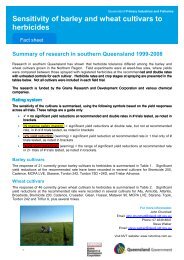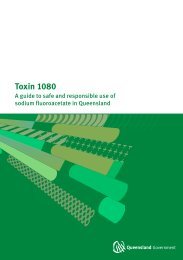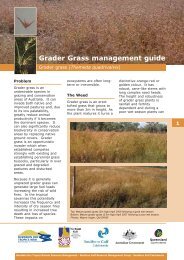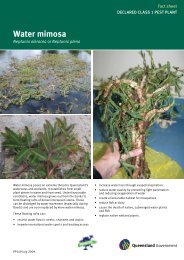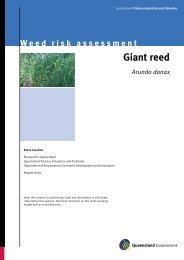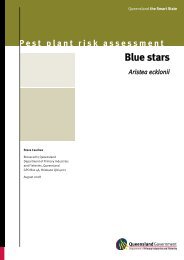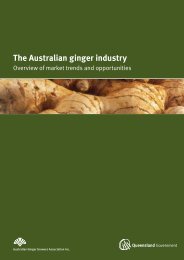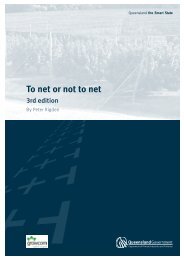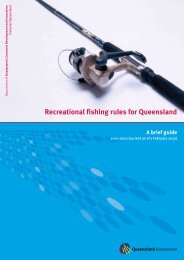Feathertop Rhodes grass - Department of Primary Industries
Feathertop Rhodes grass - Department of Primary Industries
Feathertop Rhodes grass - Department of Primary Industries
Create successful ePaper yourself
Turn your PDF publications into a flip-book with our unique Google optimized e-Paper software.
Northern IWM fact sheet<br />
<strong>Feathertop</strong> <strong>Rhodes</strong> <strong>grass</strong><br />
A weed best management guide<br />
Figure 1. Fallow paddock heavily infested with<br />
feathertop <strong>Rhodes</strong> <strong>grass</strong>. Chemical control at this<br />
growth stage can be very difficult<br />
Key messages<br />
CS1437 03/12<br />
Figure 2. <strong>Feathertop</strong> <strong>Rhodes</strong> infestation in sorghum in<br />
Central Queensland<br />
• <strong>Feathertop</strong> <strong>Rhodes</strong> (FTR) <strong>grass</strong> requires an integrated and intensive management approach; there are<br />
no silver bullets for easy management.<br />
• Seed set must be stopped or minimised to break the life cycle and reduce future weed burdens.<br />
• Large weeds (> 10 cm, tillering or with seed heads) are very difficult to kill with knockdown herbicides.<br />
• Small, actively growing weeds (< 5 cm, pre-tillering) should be targeted when using post-emergence<br />
herbicides.<br />
• The double-knock tactic is very effective, particularly with a Group A herbicide followed by a Group L<br />
herbicide. The knock interval should be at least 7 days for maximum effectiveness; adding residual<br />
herbicides to the second knock may improve the Group L knockdown.<br />
• The effectiveness <strong>of</strong> pre-emergence herbicides (residuals) can be maximised by applying them when<br />
the soil surface has very little or no weed cover.<br />
• Escapes and survivors should be monitored and spot treated as soon as possible.<br />
• Strategic tillage, to bury seed or control large plants, has a role to play but may not suit all situations.<br />
• Competitive crops and cultivars should be planted, and narrow row spacings and high crop<br />
populations used where possible.<br />
• Crops that allow the use <strong>of</strong> the <strong>grass</strong>-active Group A (‘fops’ and ‘dims’) herbicides <strong>of</strong>fer alternatives<br />
to glyphosate and allow for herbicide group rotation; the fops appear to better than the dims.<br />
• Crops should be planted into weed-free soil and pre-emergence herbicides used. Weeds should<br />
be treated in-crop with post-emergence herbicides (over-the-top or shielded boom) or inter-row<br />
tillage if required.
Where and why is feathertop <strong>Rhodes</strong><br />
<strong>grass</strong> a problem?<br />
<strong>Feathertop</strong> <strong>Rhodes</strong> (FTR) <strong>grass</strong> is a major weed<br />
in broadacre cropping systems in Central<br />
Queensland (CQ), the Darling Downs and Western<br />
Downs regions <strong>of</strong> southern Queensland, and in<br />
northern New South Wales. A recent scoping study <strong>of</strong><br />
coastal and northern Queensland cropping revealed<br />
FTR to be a main weed in those farming systems as<br />
well. Interstate inquiries indicate it is also a problem<br />
in the vineyards and orchards <strong>of</strong> South Australia, and<br />
in parts <strong>of</strong> the Western Australian grain region. FTR<br />
has proven very difficult to control.<br />
Previously a weed <strong>of</strong> roadsides, fence lines and<br />
wasteland areas, FTR has now become an issue in<br />
cropping country, particularly where minimum or<br />
zero tillage has been practiced for several years. It<br />
is not overly susceptible to glyphosate herbicide,<br />
particularly after the early tillering stage. The<br />
prolonged use and reliance on glyphosate in the<br />
fallows <strong>of</strong> these cropping systems has assisted<br />
with a species shift towards this <strong>grass</strong>. For the<br />
same reason, FTR has also recently become an<br />
issue in glyphosate-tolerant cotton systems. With<br />
minimal disturbance, the seed remains in the upper<br />
soil surface, which is ideal for emergence and<br />
perpetuation <strong>of</strong> the weed. Dry conditions have made<br />
management difficult, allowing seed bank buildup.<br />
Very wet seasons have been associated with<br />
substantial field population increases. While FTR<br />
has a preference for lighter textured soils, it will also<br />
survive on heavier clay soils.<br />
Know the enemy<br />
Description<br />
FTR (Chloris virgata Sw.) is a tufted annual <strong>grass</strong> up<br />
to 1 m tall with erect and semi-prostrate branched<br />
stems capable <strong>of</strong> rooting at the joints. Leaf blades<br />
are bluish green, 5 to 25 cm long and 3 to 6 mm wide.<br />
The seed heads or panicles have 7 to 19 feathery,<br />
white-silver spikes that are 3 to 9 mm long. The<br />
feathery appearance comes from the stiff white hairs<br />
and awns arising from the seeds. Unlike common<br />
<strong>Rhodes</strong> <strong>grass</strong>, FTR panicles tend to remain unsplayed<br />
and pointing upwards. Seedlings are erect but with<br />
flattened stem bases, and this flattening becomes<br />
more obvious in older tillers. Leaf blades have tufts<br />
<strong>Feathertop</strong> <strong>Rhodes</strong> <strong>grass</strong>: a weed best management guide<br />
<strong>of</strong> hairs along the margins and where the blade<br />
joins the sheath. The stem joints are hairless and<br />
sometimes very dark. In the early growth stages, FTR<br />
can be easily confused with awnless barnyard <strong>grass</strong><br />
(Echinochloa colona).<br />
Figure 3. Early tillering FTR plants (approximately 5 cm tall).<br />
Note the stem bases have a flattened appearance<br />
Figure 4. Mature FTR plants<br />
Seed behaviour<br />
Being an annual in most situations, FTR’s dynamics<br />
are driven through the seed. Manage the seed<br />
production and recruitment, and effective control<br />
will eventuate.<br />
CQ research trials and growth cabinet studies<br />
examining germination, field emergence, persistence<br />
(viability and dormancy over time) and the effect <strong>of</strong><br />
burial depth on fresh FTR seed have shown that:<br />
2
3<br />
• Germination occurs across temperatures <strong>of</strong><br />
20 to 30 °C but a preference is shown for 25 °C<br />
and above with exposure to light.<br />
• Seed has an innate dormancy, requiring an afterripening<br />
period <strong>of</strong> approximately 6 to 10 weeks.<br />
While pre-chilling assists in breaking dormancy, it<br />
is not essential.<br />
• Approximately 25% <strong>of</strong> seed produced is nonviable<br />
(dead or incomplete), but this may vary and<br />
be influenced by growing conditions before and at<br />
seed maturation.<br />
• Seed appears to be short-lived (about 7 to 12<br />
months) irrespective <strong>of</strong> burial depth, suggesting<br />
short field persistence (Figure 5); seed exhumed<br />
% viable FTR seed<br />
(in remaining seed bank)<br />
100<br />
80<br />
60<br />
40<br />
20<br />
0<br />
0<br />
Figure 5. FTR seed bank viability over time in the CQ environment<br />
Cumulative in-field FTR emergence<br />
(% <strong>of</strong> seed bank)<br />
60<br />
50<br />
40<br />
30<br />
20<br />
10<br />
0<br />
<strong>Feathertop</strong> <strong>Rhodes</strong> <strong>grass</strong>: a weed best management guide<br />
1<br />
from depth after being buried for 12 months<br />
did not germinate even after several dormancybreaking<br />
mechanisms were applied.<br />
• The majority <strong>of</strong> field germinations occur from<br />
the 0 to 2 cm seed burial depth; over 12 months<br />
47% <strong>of</strong> seed buried near the surface germinated,<br />
compared with 5% at 5 cm and 0% at 10 cm<br />
depths.<br />
• The cumulative germination <strong>of</strong> the seed bank at<br />
or near the surface over a 12 to 18 month period<br />
(total recruitment or emergence) ranged from<br />
25% to 50% in three separate studies, with the<br />
majority <strong>of</strong> the recruitment occurring within the<br />
first 7 months (Figure 6).<br />
2 6<br />
12 18<br />
Time after seed burial (months)<br />
2 3 4<br />
5 6 7 8 9 10 11 12 13 14<br />
Seed burial (months)<br />
study 1<br />
study 2<br />
study 3<br />
15 16 17 18 19<br />
Figure 6. Cumulative in-field emergence <strong>of</strong> FTR (expressed as a percentage <strong>of</strong> the seed bank) from seed buried in the surface<br />
2 cm <strong>of</strong> soil (studies 1 and 2 used seed from the same source; all studies started at the end <strong>of</strong> summer)
Implications for management<br />
Be prepared and consider the following when<br />
developing a management plan for FTR (based on CQ<br />
research):<br />
• FTR’s very shallow or surface germination<br />
requirement means it will most likely be a<br />
problem in zero-till paddocks compared to<br />
disturbed paddocks.<br />
• FTR is likely to germinate year-round in CQ but<br />
with preference for the period between spring<br />
and autumn. Mild wet winters will also produce<br />
recruitments in CQ.<br />
• There should be limited immediate recruitment<br />
from freshly shed seed due to the after-ripening<br />
requirement, although the condition <strong>of</strong> the mother<br />
plant during seed set may determine dormancy<br />
levels and after-ripening requirements.<br />
• Seed shed during late autumn will receive<br />
immediate pre-chilling (going into winter) thus<br />
breaking dormancy and allowing germination on<br />
the first spring rains.<br />
Figure 7. A germinating FTR seed<br />
<strong>Feathertop</strong> <strong>Rhodes</strong> <strong>grass</strong>: a weed best management guide<br />
• Burying the seed deeper than 5 cm and leaving it<br />
deep and undisturbed for at least 12 months will<br />
stop seedling emergence and will significantly<br />
reduce the seed bank as the viability <strong>of</strong> seeds<br />
deteriorates.<br />
• If seed set is stopped (no further deposits are<br />
made into the seed bank), FTR problems should<br />
be diminished quickly since the existing seed<br />
bank is short-lived.<br />
Repeated field observations suggest that peak<br />
or major flushes <strong>of</strong> emergence occur if good rain<br />
(>50 mm) falls over several consecutive days,<br />
particularly in spring. These major flushes can exhaust<br />
the majority <strong>of</strong> the non-dormant viable seed bank<br />
and <strong>of</strong>fer an ideal management opportunity. Sporadic<br />
and smaller rain events facilitate a number <strong>of</strong> smaller<br />
sequential germinations, making effective control via<br />
a single management application more difficult.<br />
Figure 8. Peak flushes <strong>of</strong> FTR, just after emergence (top), and<br />
well established in close proximity to senesced mother plant<br />
(bottom)<br />
4
5<br />
Management strategies<br />
Research and industry experience have shown that successful management <strong>of</strong> FTR requires an integrated<br />
approach, with attention given to both fallow and in-crop phases. Important management considerations and<br />
principles that apply across all farming system phases include the following.<br />
• No single weed management application will effectively control FTR—use a variety <strong>of</strong> tactics in<br />
combination and over time (across rotation phases).<br />
• Aim to stop seed set to halt the perpetuation <strong>of</strong> this <strong>grass</strong> problem.<br />
• Use the density and distribution across paddocks to determine treatment type—boom, spot sprayer,<br />
aerial, or expansive versus spot tillage.<br />
• For scattered or occasional FTR infestations, make a concerted effort to prevent these from becoming<br />
bigger problems using whatever spot treatment is necessary or available.<br />
• Target small, non-stressed and actively growing plants to improve the chances <strong>of</strong> good control.<br />
Spraying small FTR seedlings as soon as possible after rain is likely to provide best control, and aerial<br />
application should be considered if it stays too wet to use ground sprayers (as the soil pr<strong>of</strong>ile dries,<br />
plant stress levels increase).<br />
• Use good herbicide application techniques to maximise coverage—appropriate nozzles, boom heights,<br />
water volumes and speed for the intended spray job.<br />
• Closely monitor the results <strong>of</strong> all management applications and spot treat survivors as soon<br />
as possible.<br />
• When using residual herbicides, the soil surface needs to have less than 50% weed or stubble cover.<br />
Ideally no weeds should be present to maximise the amount <strong>of</strong> herbicide reaching the soil surface.<br />
• If using tillage to control existing plants, ensure the depth and type <strong>of</strong> tillage is sufficient to uproot the<br />
<strong>grass</strong> without subsequently transplanting it. The rooting depth will depend on the season—roots will<br />
be shallow in dry seasons.<br />
• If using tillage for seed burial, ensure the depth <strong>of</strong> soil inversion is at least 10 cm to guarantee burial<br />
below the depth at which the weed can germinate.<br />
• Manage outbreaks along roads, fences and around sheds as these will be a continuing seed source<br />
for paddocks.<br />
Herbicide registrations<br />
The few herbicides specifically registered for the<br />
control <strong>of</strong> FTR are atrazine, butroxydim (e.g. Factor ® ),<br />
clethodim (e.g. Select ® ) and Arsenal Xpress ®<br />
(imazapyr + glyphosate for non-crop land uses only),<br />
while clorthal-dimethyl (Dacthal ® ) is registered<br />
for control <strong>of</strong> Chloris spp. in cotton. Paraquat (e.g.<br />
Gramoxone ® ) has a registration for control <strong>of</strong> annual<br />
<strong>grass</strong>es in general.<br />
A recent ‘minor use’ permit has been issued to cover<br />
FTR control in fallows prior to mungbean cropping<br />
using the double-knock technique (permit 12941).<br />
It allows haloxyfop 520 g ai/L formulations (e.g.<br />
Verdict ® 520) to be applied at 78 to 156 g ai/ha with<br />
Uptake TM spray oil additive (0.5 % v/v) which then<br />
must be followed 7 to 14 days later with paraquat<br />
(e.g. Gramoxone ® ) applied at 400 g ai/ha on to 3-leaf<br />
to early tillering FTR growing on fallow land that will<br />
be next cropped to mungbean.<br />
<strong>Feathertop</strong> <strong>Rhodes</strong> <strong>grass</strong>: a weed best management guide<br />
CQ research over the past 6 years has demonstrated<br />
several promising herbicides for the control <strong>of</strong> FTR<br />
both in fallow and in-crop. While the majority <strong>of</strong> the<br />
herbicides are registered for use in the respective<br />
situations, they do not currently have FTR listed<br />
on their labels. Current development trials being<br />
undertaken by the regional Grower Solutions<br />
groups will supply further data to support new FTR<br />
registrations.<br />
Control tactics<br />
To effectively control problem weeds such as FTR,<br />
all phases <strong>of</strong> the life cycle must be attacked using a<br />
range <strong>of</strong> chemical and non-chemical methods. The<br />
aim is to deplete the seed bank, control seedlings<br />
and small plants, stop seed set and prevent new<br />
seeds entering from outside the system.
Seed bank depletion<br />
Residual herbicides (fallow and in-crop)<br />
Fallow and crop rotation trials in CQ have shown<br />
several residual herbicides to be very effective on<br />
FTR. For in-crop situations these residuals were<br />
applied either pre-plant during the fallow or postplant<br />
prior to crop emergence. In fallow, they were<br />
applied alone or as part <strong>of</strong> a double-knock strategy,<br />
with best results most <strong>of</strong>ten occurring when applied<br />
with a Group L bipyridyl herbicide in the second<br />
knock (weed cover has been reduced by first knock<br />
and the Group L <strong>of</strong> the second knock assists with<br />
rapid plant matter desiccation and disintegration).<br />
The residual herbicides act on the germinating<br />
seeds <strong>of</strong> sequential flushes, <strong>of</strong>ten stopping<br />
establishment and thus depleting the seed bank<br />
as each cohort attempts to emerge or establish.<br />
The number <strong>of</strong> cohorts affected (length <strong>of</strong> residual<br />
activity) is determined by the herbicide rate<br />
applied, soil type, the ensuing climatic conditions<br />
and location <strong>of</strong> the seed relative to the herbicide<br />
(root/shoot accessibility).<br />
When using residuals it is important that the<br />
herbicides reach the soil surface, so application<br />
is best made to bare soil that is weed and stubble<br />
free. Rain should be received within 14 days <strong>of</strong><br />
application to allow incorporation below the surface<br />
into the seed zone and to minimise the amount lost<br />
to ultraviolet degradation. The best time to apply is<br />
prior to the sowing rain (herbicide will control FTR<br />
plants emerging with the crop). Applying immediately<br />
after sowing is an alternative, but this tends to be<br />
less effective if follow-up rain is not received soon<br />
after. Application water volumes should be kept<br />
high (80 to 100 L/ha) for best results. Re-cropping<br />
opportunities may be limited where residuals have<br />
been used so consult herbicide labels to determine<br />
the plant-back periods.<br />
Fallow<br />
Effective residuals applied in the fallow (<strong>of</strong>ten as part<br />
<strong>of</strong> a double-knock strategy) have included a Group C<br />
triazine mixed with a Group K chloroacetamide, and<br />
a Group B imidazolinone (see Table 1). Six years <strong>of</strong><br />
CQ research data on FTR have also shown that the<br />
Group C and K herbicides are more effective and<br />
long-lasting when mixed together than when either<br />
is applied alone. The same research has shown that<br />
when these herbicides are applied in fallows during<br />
<strong>Feathertop</strong> <strong>Rhodes</strong> <strong>grass</strong>: a weed best management guide<br />
the cooler months, the duration <strong>of</strong> control is several<br />
months longer compared to fallow use in summer.<br />
In-crop<br />
The FTR-effective residual herbicides applied<br />
immediately pre-plant, at planting or post-plant preemergence<br />
in CQ research trials have included:<br />
• sorghum: Group C triazine + Group K<br />
chloroacetamide<br />
• wheat: Group B sulfonylurea; Group K<br />
chloroacetamide; Group D dinitroaniline<br />
(see Table 1)<br />
• chickpea: Group K chloroacetamide; Group C<br />
triazine + Group F isoxazole<br />
• mungbean: Group D dinitroaniline; Group B (1)<br />
and (2) imidazolinones (see Table 1)<br />
• sunflower: Group C triazine; Group D (1) and (2)<br />
dinitroanalines; Group K chloroacetamide (see<br />
Table 1).<br />
All <strong>of</strong> these herbicides are registered for use in the<br />
respective crops (except Group B (2) imidazolinone<br />
in mungbean) but not for the control <strong>of</strong> FTR.<br />
Further development work with these herbicides is<br />
continuing.<br />
Strategic tillage alone or in combination with<br />
residual herbicides (fallow)<br />
Since FTR germinates at or very near the soil surface,<br />
burying the seed below 5 cm will place the seed<br />
too deep for germination. Strategic tillage can be<br />
used to do this, and CQ research has shown that<br />
deep inversion (25 cm) tillage completely stops<br />
FTR emergences for as long as 9 months after<br />
implementation. Other tillage types provided a<br />
range <strong>of</strong> control from 1% to 89% for the same period.<br />
Application <strong>of</strong> a residual herbicide with tillage can<br />
also be beneficial in reducing the seed bank (see<br />
Figure 9).<br />
Harrows and Kelly chains can be used to ‘tickle’ the<br />
upper 5 cm <strong>of</strong> soil to create an ideal seedbed for FTR<br />
germination. Several field observations have been<br />
made in CQ that show these tickle tillage operations<br />
facilitate peak flushes <strong>of</strong> FTR emergence. These<br />
flushes virtually exhaust the seed bank and present<br />
excellent opportunities for early post-emergence<br />
management.<br />
6
7<br />
Table 1. Impact <strong>of</strong> residual herbicides used in various crops on FTR dynamics measured in a replicated research trial at<br />
Biloela Research Station<br />
Crop and residual herbicide FTR reduction (%)<br />
Wheat (50 cm wide rows)<br />
no herbicides 72<br />
Group B sulfonylurea 100<br />
Group D dinitroanaline 94<br />
Group K chloroacetamide 91<br />
Wheat (25 cm wide rows)<br />
no herbicides 100<br />
Group B sulfonylurea 100<br />
Group D dinitroanaline 75<br />
Group K chloroacetamide 100<br />
Sunflowers<br />
Group D (1) dinitroanaline 100<br />
Group K chloroacetamide 100<br />
Group D (2) dinitroanaline 100<br />
Group C triazine 100<br />
Mungbeans<br />
Group D dinitroanaline 100<br />
Group B (1) imidazolinone 100<br />
Group B (2) imidazolinone 100<br />
no residual only post-emergence knockdowns 100<br />
Fallow<br />
double-knock: Group M followed by Group L + Group B imidazolinone 100<br />
3 sequential double-knocks (Group M followed by Group L) without residuals 100<br />
FTR control (%)<br />
100<br />
90<br />
80<br />
70<br />
60<br />
50<br />
40<br />
30<br />
20<br />
10<br />
Figure 9. Impact <strong>of</strong> different tillage types, some with residual herbicides included, on the control <strong>of</strong> FTR at 9 months after<br />
application after receiving > 200 mm rain<br />
0<br />
deep inversion<br />
<strong>of</strong>fset discs<br />
scarifier<br />
<strong>Feathertop</strong> <strong>Rhodes</strong> <strong>grass</strong>: a weed best management guide<br />
harrows<br />
Tillage treatments<br />
scarifier +<br />
herbicides<br />
zero till +<br />
herbicides
Seedlings and small plant control<br />
Post-emergence herbicides (in-crop and in fallow)<br />
Fallow<br />
FTR does not appear in the lists <strong>of</strong> weeds controlled<br />
on the labels <strong>of</strong> any fallow-registered knockdown<br />
herbicide. However as noted previously, minor use<br />
permit 12941 allows a double-knock <strong>of</strong> Verdict ® 520<br />
(Group A) followed by paraquat (Group L) but only in<br />
fallows that will be planted to mungbean.<br />
Research in CQ has shown that once FTR is past early<br />
tillering stage, a Group M (glycine) herbicide used<br />
alone becomes ineffective, but if a Group L bipyridyl<br />
herbicide is applied sequentially, control approaches<br />
100%. This double-knock tactic (see Figures 10 and<br />
11) has proved to be the most consistently effective<br />
across a range <strong>of</strong> growth stages and plant stress<br />
conditions. The same research has also shown that<br />
the addition <strong>of</strong> residuals (particularly Group B) to<br />
the second knock enhances the knockdown <strong>of</strong> the<br />
Group L herbicide (Figure 12).<br />
Figure 10. Double-knock on FTR in fallow (Group M herbicide<br />
followed 10 days later with Group L mixed with Group C<br />
and K residual herbicides)<br />
<strong>Feathertop</strong> <strong>Rhodes</strong> <strong>grass</strong>: a weed best management guide<br />
Figure 11. Untreated FTR (top) compared to the success <strong>of</strong> the<br />
double-knock (Group M herbicide followed 11 days later by<br />
Group L mixed with a Group B residual herbicide) (bottom)<br />
Since the double-knock is a sequential application<br />
<strong>of</strong> herbicides, the interval between knocks is<br />
important to overall efficacy. For many weeds, the<br />
interval is short (3 to 4 days) but for FTR, a minimum<br />
<strong>of</strong> 7 days is necessary when using a Group M as the<br />
first knock. This is probably due to an antagonism<br />
that occurs inside the plant and is specific to<br />
FTR. Research conducted by the Northern Grower<br />
Alliance discovered this anomaly (Figure 13), which<br />
is being investigated further by researchers in the<br />
newly funded Grains Research and Development<br />
8
9<br />
Corporation (GRDC) project ‘Improving IWM practices<br />
in the Northern Region’.<br />
Current field trials conducted by the CQ Growers<br />
Solutions project are showing that the double-knock<br />
tactic <strong>of</strong> a Group A herbicide followed by Group L with<br />
residuals (particularly Group B) is far superior to the<br />
double-knock where a Group M herbicide is applied<br />
as the first knock. These trials are also showing that<br />
as FTR density increases, the rate <strong>of</strong> the Group A first<br />
knock needs to increase to maintain good efficacy.<br />
FTR knockdown control (%)<br />
100<br />
95<br />
90<br />
85<br />
80<br />
75<br />
<strong>Feathertop</strong> <strong>Rhodes</strong> <strong>grass</strong>: a weed best management guide<br />
Ideally, a herbicide-based double-knock tactic<br />
works best when applied to small, actively growing<br />
weeds, and rates for both knocks should be kept<br />
robust. Costs <strong>of</strong> the double-knock can be reduced by<br />
applying the second knock as a spot spray (density<br />
dependent) or using weed detection technology<br />
if available. Spot tillage may also be an option. In<br />
some instances the second knock may be a tillage<br />
operation instead <strong>of</strong> herbicide.<br />
L only L + K L + C L + C + K L + B<br />
Herbicide groups applied in the second knock<br />
Figure 12. Impact <strong>of</strong> the residual herbicides (Groups K, C and B) with Group L in the second knock <strong>of</strong> a double-knock tactic on<br />
the knockdown control <strong>of</strong> FTR. The first knock was a robust rate <strong>of</strong> a Group M herbicide. Data are the means <strong>of</strong> three CQ trials<br />
FTR control (%)<br />
100<br />
80<br />
60<br />
40<br />
20<br />
0<br />
0 4 12 19<br />
Time interval between knocks (days)<br />
Figure 13. Effect <strong>of</strong> time interval between the first (Group M herbicide) and second knocks (Group L herbicide) <strong>of</strong> the doubleknock<br />
tactic on control <strong>of</strong> FTR in a southern Queensland trial. The ‘0’ day treatment only received the first knock (data source:<br />
Northern Grower Alliance)
In-crop<br />
In-crop management <strong>of</strong> FTR will be limited by the crop<br />
chosen and the herbicides that can be safely used<br />
with those crops. For post-emergence control in-crop,<br />
shielded sprayers may be required (Group L and M<br />
herbicides in most crops, and Group A herbicides<br />
in some <strong>grass</strong> and cereal crops). Local research has<br />
shown that several <strong>of</strong> the <strong>grass</strong>-selective Group A<br />
herbicides have good efficacy on FTR, and the ‘fop’<br />
chemistry appears to better than the ‘dims’ and ‘dens’,<br />
although butroxydim and clethodim are the only<br />
Group A herbicides registered in-crop for FTR control.<br />
The <strong>grass</strong>-selective knockdown herbicides are widely<br />
used in the broad-leaved crops such as mungbean,<br />
chickpea, cotton and sunflower (see Figures 14 and<br />
15). Growing these crops in the rotation plays an<br />
important role in managing FTR and also in managing<br />
herbicide resistance for other high-risk summer<br />
<strong>grass</strong>es. There are also certain Group A herbicides<br />
used in wheat and barley that provide good postemergence<br />
efficacy on FTR, so winter cereals should<br />
be considered as an option in the development <strong>of</strong> an<br />
integrated weed management (IWM) plan.<br />
Figure 14. Group A herbicide applied in sunflower to<br />
control FTR<br />
Figure 15. Group A herbicide applied over the top <strong>of</strong><br />
mungbean to effectively control FTR<br />
<strong>Feathertop</strong> <strong>Rhodes</strong> <strong>grass</strong>: a weed best management guide<br />
Tillage<br />
Cultivation, including inter-row tillage, is an<br />
alternative option to control emerged FTR in fallows<br />
and in-crop. However for the latter, crop rows need<br />
to be wide enough and the crop short enough<br />
to facilitate passage <strong>of</strong> the implements without<br />
sustaining damage to the crop. In many cases<br />
inter-row tillage is only an option in the early crop<br />
growth stages. Tillage is best performed when<br />
soil conditions are dry to avoid the possibility <strong>of</strong><br />
transplanting.<br />
Success <strong>of</strong> tillage for FTR control during the<br />
fallow hinges on plant size and type <strong>of</strong> cultivation<br />
undertaken. Small FTR plants are easily removed,<br />
particularly if moisture stressed and shallow rooted,<br />
by Kelly chains or similar equipment. The experiences<br />
<strong>of</strong> a few growers suggest that the use <strong>of</strong> a fallow<br />
knockdown herbicide followed several days later by<br />
a shallow tillage (another example <strong>of</strong> a double-knock<br />
tactic) with a Kelly chain works best when the FTR is<br />
no larger than the early tillering stage. As mentioned<br />
previously, tickle tillage can be used to promote peak<br />
flushes <strong>of</strong> emergence that can then be targeted with<br />
the herbicide-based double-knock tactic.<br />
When FTR plants are large and clumped, tillage<br />
that uproots and chops the material is best—<br />
tandem <strong>of</strong>fset discs and chisel ploughs should be<br />
considered. If FTR densities are low and plants are<br />
scattered, spot tillage (e.g. a single-tined sweep)<br />
may be a minimum tillage option.<br />
Stopping/reducing seed set<br />
All <strong>of</strong> the herbicide and tillage tactics described so<br />
far, when applied using best management principles,<br />
should provide good control <strong>of</strong> FTR and significantly<br />
reduce seed production. Most weed control tactics<br />
rarely achieve 100% control, so escapes or survivors<br />
will be present. For difficult-to-control weeds that<br />
perpetuate through the seed, it becomes critical<br />
to stop seed set in these survivors; otherwise the<br />
problem will continue. Post-treatment monitoring <strong>of</strong><br />
all weed management practices is paramount to the<br />
success <strong>of</strong> any IWM plan as it allows for the detection<br />
<strong>of</strong> survivors. These should then be re-treated by spot<br />
tillage, spot spraying including weed sensor spray<br />
technology, or manual removal as soon as possible<br />
to stop any further seed set.<br />
10
11<br />
Growing competitive crops will also assist in<br />
reducing seed production. Using manipulative<br />
agronomy to maximise crop competition allows the<br />
crop itself to become an adjunct weed management<br />
tool. This involves:<br />
• selecting the most competitive crop (traditionally,<br />
barley is more competitive than wheat, maize is<br />
more competitive than sorghum)<br />
• selecting the most competitive cultivars<br />
• sowing into a clean seedbed to give the<br />
competitive advantage to the crop<br />
• aiming to establish the highest crop population<br />
according to the cultivar and region<br />
• keeping row spacings to the minimum for the<br />
cultivar and region<br />
• ensuring good crop nutrition and crop protection<br />
practices (insect and disease control).<br />
If you are unable to take advantage <strong>of</strong> crop<br />
competition and crops are being grown on wide<br />
rows, it becomes very important to use in-crop<br />
FTR management practices (see Figure 16). Take<br />
advantage <strong>of</strong> the wide-row spacing to utilise interrow<br />
tillage or shielded spraying (summer cereals).<br />
The wide inter-row space also facilitates easier and<br />
greater herbicide penetration below the crop canopy,<br />
which is ideal for the Group A <strong>grass</strong>-selectives<br />
applied in broad-leaved crops.<br />
Pre-harvest desiccant sprays can also be utilised<br />
(where registered) to contribute to the control <strong>of</strong><br />
late in-crop FTR emergences or the survivors <strong>of</strong><br />
earlier management practices. Observations made<br />
on local research trials have noted that applications<br />
<strong>of</strong> Group M herbicide (which is also a common<br />
pre-harvest herbicide) causes FTR seed shed within<br />
2 to 3 days <strong>of</strong> spraying. This is particularly valuable<br />
if the seed being shed is not physiologically mature<br />
at the time.<br />
<strong>Feathertop</strong> <strong>Rhodes</strong> <strong>grass</strong>: a weed best management guide<br />
Figure 16. Dense infestation <strong>of</strong> FTR in a CQ wide-row wheat<br />
crop that has not received any in-crop <strong>grass</strong> management<br />
Preventing new seeds entering from outside<br />
FTR plants growing along farm tracks and paddock<br />
verges, on fence lines and around sheds and<br />
buildings are a seed source for nearby paddocks<br />
since the seed can be dispersed short distances<br />
by wind, and carried on animal fur and on vehicles<br />
and farm equipment that pass through the areas.<br />
Ideally, these areas should be kept FTR-free but not<br />
bare since FTR (and fleabane) are among the first<br />
plants to colonise bare areas. Sturdy, non-invasive,<br />
low-growing ground covers should be encouraged in<br />
these areas.
More information<br />
For further information contact:<br />
Michael Widderick<br />
Crop and Food Science, Agri-Science Queensland<br />
Toowoomba, Queensland<br />
Phone: (07) 4639 8888<br />
michael.widderick@deedi.qld.gov.au<br />
Tony Cook<br />
Tamworth Agricultural Institute<br />
NSW DPI<br />
Phone: (02) 6763 1250<br />
tony.cook@dpi.nsw.gov.au<br />
Your local Grower Solutions team:<br />
Northern Grower Alliance<br />
Phone: (07) 4639 5344<br />
lawrie.price@nga.org.au<br />
Central Queensland<br />
Phone: (07) 4983 7400<br />
richard.sequeira@deedi.qld.gov.au<br />
Prepared by Vikki Osten with input from Michael<br />
Widderick (<strong>Department</strong> <strong>of</strong> Agriculture, Fisheries and<br />
Forestry), Tony Cook (NSW DPI), Steven Walker (The<br />
University <strong>of</strong> Queensland), Lawrie Price (Northern<br />
Grower Alliance) and Graham Spackman (Central<br />
Queensland Grower Solutions).<br />
12





